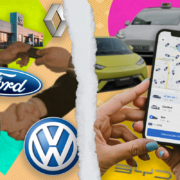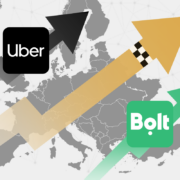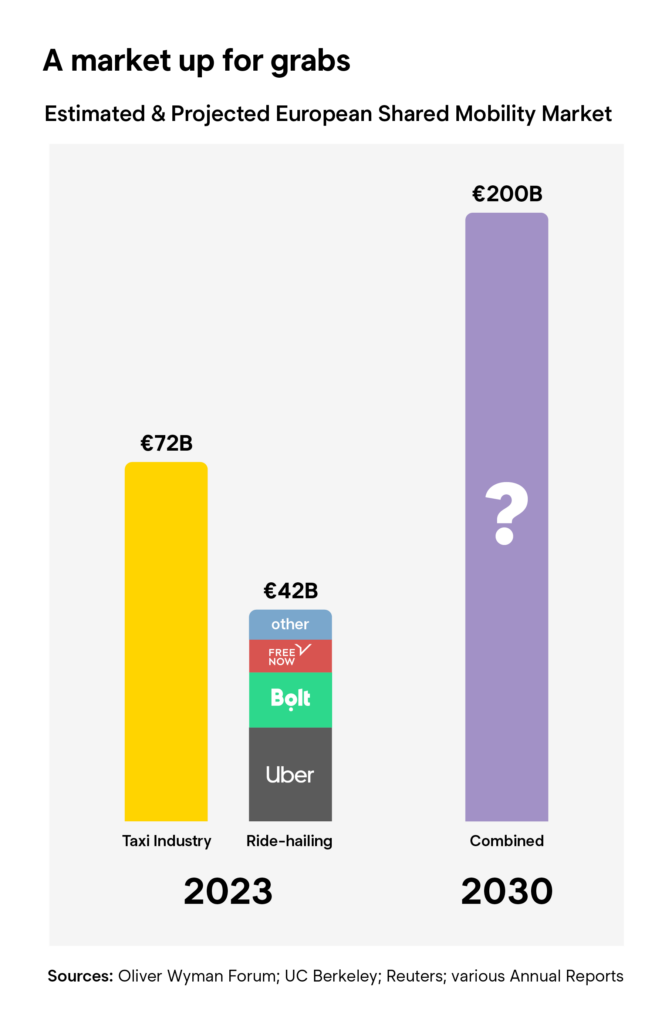The Urban Mobility Gold Rush
In the race for urban mobility dominance, local players and tech giants alike are staking their claim. Who will strike digital gold?
In the bustling cityscape of 2025, a modern-day gold rush is underway. But instead of pickaxes and pans, the tools of choice are smartphones and algorithms. From seasoned taxi operators to nimble startups, everyone’s racing to stake their claim in the app-driven mobility market. The price? A share of the global ride-hailing market projected to reach €200 billion by 2030.
The New Urban Frontier
The urban transportation landscape of 2025 is a far cry from the simple point A to point B journeys of yesteryear. Today’s commuters demand convenience, sustainability, and seamless user experiences. Ride-hailing apps have set new standards, offering features like real-time tracking, cashless payments, and dynamic pricing that have left traditional operators scrambling to keep up.
As cities grapple with congestion and emissions, app-based services have become the new sheriffs in town, integral to modern urban planning. This shift has created a gold rush mentality, with smaller players seeing an opportunity to strike it rich by launching their own tailored apps.
Competing with the Giants
The urban mobility landscape is dominated by tech giants like Uber, Bolt, and Lyft. These behemoths have set the standard for ride-hailing services, but their global approach often leads to frustration for local players looking to compete. New market entrants are no longer satisfied with basic dispatch solutions; instead, they seek a more comprehensive product with advanced features that give them a fighting chance. They are looking for full-fledged ride-hailing apps that can rival the features and user experience offered by the industry leaders.
This growing demand for powerful, feature-rich ride-hailing solutions is exactly where eCabs Technologies stands out. Unlike generalist tech companies, eCabs Tech has focused solely on building a state-of-the-art ride-hailing platform. By leveraging the combined expertise of our tech team and expansion specialists, we have created a solution that allows local operators to compete on an equal footing with global giants.
Why Everyone’s Joining the App Rush
- Staking Their Claim: Traditional taxi operators are tired of playing second fiddle to global platforms. By launching their own apps, they can plant their flag, set fair prices, and build their brand identity.
- Local Knowledge is King: Unlike global giants, local operators understand their community’s unique needs and can offer tailored services that address specific regional concerns. For example, eCabs Malta introduced the “Woman+” category, allowing female passengers to select female drivers, enhancing safety and comfort for women riders, and the “Malti+” category specifically for Maltese-speaking drivers and passengers.
- The Mother Lode: With the ride-hailing market set to hit €200 billion by 2030, even a small claim can yield a fortune.
- Government Backing: Some regions are offering tax breaks or exclusive access to certain areas for homegrown solutions, akin to land grants in the old gold rush days.
- Tools of the Trade: Developing an app is no longer like panning for gold with bare hands. White-label solutions and app development platforms have made it easier than ever for businesses to launch their own branded apps.
Striking Digital Gold Isn’t Easy
While the potential rewards are glittering, launching an app comes with its own set of challenges:
- Technical Expertise: Building a robust, user-friendly app requires specialised skills.
- Market Competition: The field is crowded, and standing out requires a clear value proposition.
- Operational Complexity: Managing a digital platform is akin to running a complex mining operation.
- Customer Acquisition: Attracting users in a saturated market demands smart prospecting strategies.
This is where companies like eCabs Technologies come in, offering the modern-day mining equipment and expertise needed to succeed.
eCabs Technologies: Your Partner in the Digital Gold Rush
In this new frontier, eCabs Technologies emerges as a crucial ally, providing not just the tools but also the expertise to navigate the complex terrain of app-driven mobility. Our offering goes beyond mere app development, encompassing a comprehensive suite of services designed to help businesses strike gold in the digital mobility landscape.
What sets eCabs Technologies apart is our Growth & Expansion department acting as experienced prospectors guiding businesses through every step of their journey:
- Strategic Planning: Developing competitive strategies to help businesses stand out in the market and compete effectively with industry leaders.
- Operational Guidance: Providing insights on fleet management, driver onboarding, and operational efficiency.
- Marketing Expertise: Crafting strategies to attract users and build brand loyalty in a competitive market.
- Continuous Improvement: Offering ongoing support to refine operations and maximise success post-launch.
The value of this “handholding” approach cannot be overstated. For many partners, particularly traditional taxi operators, transitioning from conventional operations to a tech-driven model can be as daunting as venturing into uncharted territory. eCabs Technologies’ Growth & Expansion team provides the steady guidance needed to navigate this new landscape successfully, offering not just technology but also the strategic expertise to use it effectively.
The Future of Urban Mobility
As urban mobility continues to evolve, the app gold rush will only intensify. For businesses willing to adapt, invest and innovate, the opportunities are as vast as the unexplored territories of old. With the right technology partner and strategic guidance, it is possible not just to compete with giants but to carve out a thriving business in this new landscape.
In this gold rush, the real winners aren’t just those who move people, but those who move fast, think smart, and partner wisely. With a skilled ally in eCabs Technologies, ambition can indeed be translated into success.
By Molka Sfar, Growth and Expansion Manager








